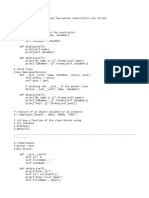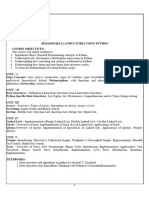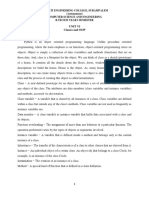1.
From class to dataclass
Class A has a single attribute _length that is not set in the initializer. If you convert this to a data class, you
need to use the field function and indicate that the _length field shouldn't be in the initializer. Secondly,
you need to supply the default argument to the field function as well so that _length is initially 0. This is
what that looks like (assuming _length is an integer):
@dataclass
class A:
_length: int = field(init=False, default=0)
Alternatively, you can add the __post_init__ dunder method to set the default value, like so:
@dataclass
class A:
_length: int = field(init=False)
def __post_init__(self) -> None:
self._length = 0
Class B has three instance variables including a list of integers. If the list is not provided it's set to the empty
list by default. In a dataclass this is achieved using the default_factory argument of field:
@dataclass
class B:
x: int
y: str = "hello"
l: list[int] = field(default_factory=list)
Note that with dataclasses you have to make sure that instance variables that don't have a default value are
placed above variables with a default value. The reason is that the order in which you define the fields
determines the order of the arguments, and arguments without default value can't come after arguments
with a default value in Python.
Alright, on to class C. Here we have two instance variables, but only the first one is provided and the second
one depends on the value of the first one. Here we need to rely on __post_init__ to assign the value to b
after a has been set, and we also need to make sure that you can't set b in the initializer. This is the
dataclass that achieves this:
@dataclass
class C:
a: int = 3
� b: int = field(init=False)
def __post_init__(self) -> None:
self.b = self.a + 3
As you can see, dataclasses are not always shorter to write than regular classes (the dataclass version of C
adds an extra line with regards to the regular version). But then again, shortness shouldn't be the only
decision factor in whether you should use a dataclass or a regular class, because of the many other benefits
that dataclasses offer such as having a nicely printable version of the object and being able to see at a
glance what the instance variables are of a dataclass since they're all defined at the top.
Dataclasses also make it easier to use a performance-optimized version of a class using the slots
mechanism. For example, this is a more performant version of class B:
@dataclass(slots=True)
class B:
x: int
y: str = "hello"
l: list[int] = field(default_factory=list)
2. Let's sell some phones
Here's a possible solution:
@dataclass
class Customer:
name: str
street: str
postal_code: str
city: str
email :str
@dataclass
class Phone:
brand: str
model: str
price: int
serial: str
@dataclass
class Plan:
customer: Customer
phone: Phone
start_date: datetime
duration_months: int
price: int
phone_included: bool = False
�The important thing here is that Plan should define the relationship between customers and phones. I've
chosen to set the phone_included field to False by default. Also note that I use integers for representing
prices. This is a standard practice in finance (though Decimal can also be used). If you use an integer to
represent the price, the unit should be the smallest monetary unit for the currency. For example, if the
currency is US dollar, the smallest unit is cent. So a price of $100.00 is stored as the value 10000 (ten
thousand cents).
There are many other ways to define the representation. For example, you could introduce an Address
class that contains address information and then each customer could have one or more addresses:
@dataclass
class Address:
street: str
postal_code: str
city: str
@dataclass
class Customer:
name: str
addresses: list[Address] = field(default_factory=list)
email :str
The nice thing about this change is that it now allows customers to have multiple addresses, for example a
customer can now have a billing address that's different from the delivery address.

























































